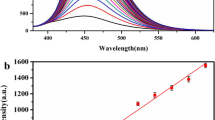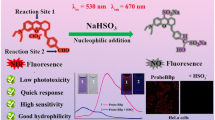Abstract
Carbon monoxide (CO) is one of the signaling molecules that are ubiquitous in humans, which involves in the regulation of human physiology and pathology. In this work, the probe PEC was designed and synthesized based on BODIPY fluorophore that can selectively detect CO through reducing the nitro group to amino group, resulting in a “turn-on” fluorescence response with a simultaneous increase in the concentration of CO. The response is selective over a variety of relevant reactive free radicals, ions, and amino acid species. PEC has the advantages of good stability, good water solubility, and obvious changes in fluorescence signals. In addition, PEC can be used to detect and track endogenous CO in living cells.







Similar content being viewed by others
Data Availability
Supplementary material related to this article can be found in the online version.
References
Zhou F, Hu X, Gao M, Cheng T, Liu G (2016) An imidazolium-modified chiral rhodium/diamine-functionalized periodic mesoporous organosilica for asymmetric transfer hydrogenation of α-haloketones and benzils in aqueous medium. Green Chem 18:5651–5657
Wu D, Sedgwick AC, Gunnlaugsson T, Akkaya EU, Yoon J, James TD (2017) Fluorescent chemosensors: the past, present and future. Chem Soc Rev 46:7105–7123
Chan J, Dodani SC, Chang CJ (2012) Reaction-based small-molecule fluorescent probes for chemoselective bioimaging. Nat Chem 4:973–984
Motterlini R, Otterbein LE (2010) The therapeutic potential of carbon monoxide. Nat Rev Drug Discov 9:728–743
Chen T-R, Wu F-S, Lee H-P, Chen KHC (2016) Diiridium Bimetallic Complexes function as a redox switch to directly Split Carbonate into Carbon Monoxide and Oxygen. J Am Chem Soc 138:3643–3646
Wang X, Yu S, Liu W, Fu L, Wang Y, Li J, Chen L (2018) Molecular imprinting based hybrid ratiometric fluorescence Sensor for the visual determination of bovine hemoglobin. ACS Sens 3:378–385
Yang J, Zhou J, Lv Z, Wei W, Song H (2015) A real-time monitoring system of Industry Carbon Monoxide based on Wireless Sensor Networks. Sensors 15:29535–29546
Tang Z, Song B, Ma H, Luo T, Guo L, Yuan J (2019) Mitochondria-Targetable Ratiometric Time-Gated Luminescence Probe for Carbon Monoxide based on Lanthanide Complexes. Anal Chem 91:2939–2946
Yuan L, Lin W, Tan L, Zheng K, Huang W (2013) Lighting up Carbon Monoxide: fluorescent probes for monitoring CO in living cells. Angew Chem Int Ed 52:1628–1630
Wu L, Wang R, Monoxide C (2005) Endogenous production, physiological functions, and pharmacological applications. Pharmacol Rev 57:585–630
Milas L, Hittelman WN (2009) Cancer Stem cells and Tumor Response to Therapy: current problems and future prospects. Semin Radiat Oncol 19:96–105
Kitamuro T, Takahashi K, Ogawa K, Udono-Fujimori R, Takeda K, Furuyama K, Nakayama M, Sun J, Fujita H, Hida W, Hattori T, Shirato K, Igarashi K, Shibahara S (2003) Bach1 functions as a hypoxia-inducible repressor for the Heme Oxygenase-1 gene in human cells. J Biol Chem 278:9125–9133
de la Torre C, Toscani A, Marín-Hernández C, Robson JA, Terencio MC, White AJP, Alcaraz MJ, Wilton-Ely JDET, Martínez-Máñez R, Sancenón F (2017) Ex vivo Tracking of endogenous CO with a ruthenium(II) complex. J Am Chem Soc 139:18484–18487
Jia R, Song P, Wang J, Mai H, Li S, Cheng Y, Wu S (2018) Self-assembled fluorescent nanoprobe based on Forster Resonance Energy transfer for Carbon Monoxide in living cells and animals via ligand exchange. Anal Chem 90:7117–7121
Morita T, Mitsialis SA, Koike H, Liu Y, Kourembanas S (1997) Carbon Monoxide controls the proliferation of hypoxic vascular smooth muscle cells. J Biol Chem 272:32804–32809
Ling K, Men F, Wang W-C, Zhou Y-Q, Zhang H-W, Ye D-W (2018) Carbon Monoxide and its controlled release: therapeutic application, detection, and development of Carbon Monoxide releasing molecules (CORMs). J Med Chem 61:2611–2635
Measurement of Endogenous (2002) Carbon Monoxide formation in Biological Systems. Antioxid Redox Sign 4:271–277
Esteban J, Ros-Lis JV, Martínez-Máñez R, Marcos MD, Moragues M, Soto J, Sancenón F (2010) Sensitive and selective chromogenic sensing of Carbon Monoxide by using Binuclear Rhodium Complexes. Angew Chem Int Ed 49:4934–4937
Moragues ME, Esteban J, Ros-Lis JV, Martínez-Máñez R, Marcos MD, Martínez M, Soto J, Sancenón F (2011) Sensitive and selective chromogenic sensing of Carbon Monoxide via Reversible Axial CO Coordination in Binuclear Rhodium Complexes. J Am Chem Soc 133:15762–15772
Benito-Garagorri D, Puchberger M, Mereiter K, Kirchner K (2008) Stereospecific and reversible CO binding at Iron Pincer Complexes. Angew Chem Int Ed 47:9142–9145
Yan T, Chen J, Wu S, Mao Z, Liu Z (2014) A rationally designed fluorescence Chemosensor for On-Site monitoring of Carbon Monoxide in Air. Org Lett 16:3296–3299
Ohata J, Bruemmer KJ, Chang CJ (2019) Activity-based sensing methods for monitoring the reactive Carbon Species Carbon Monoxide and Formaldehyde in Living Systems. Acc Chem Res 52:2841–2848
Marín-Hernández C, Toscani A, Sancenón F, Wilton-Ely JDET, Martínez-Máñez R (2016) Chromo-fluorogenic probes for carbon monoxide detection. Chem Comm 52:5902–5911
Liu X, Li N, Li M, Chen H, Zhang N, Wang Y, Zheng K (2020) Recent progress in fluorescent probes for detection of carbonyl species: Formaldehyde, carbon monoxide and phosgene. Coord Chem Rev 404:213109
Kumar N, Bhalla V, Kumar M (2013) Recent developments of fluorescent probes for the detection of gasotransmitters (NO, CO and H2S). Coord Chem Rev 257:2335–2347
Heinemann SH, Hoshi T, Westerhausen M, Schiller A (2014) Carbon monoxide – physiology, detection and controlled release. Chem Comm 50:3644–3660
Zhang W, Wang Y, Dong J, Zhang Y, Zhu J, Gao J (2019) Rational design of stable near-infrared cyanine-based probe with remarkable large Stokes Shift for monitoring Carbon monoxide in living cells and in vivo. Dye Pigment 171:107753
Tian X, Liu X, Wang A, Lau C, Lu J (2018) Bioluminescence Imaging of Carbon Monoxide in living cells and Nude mice based on Pd0-Mediated tsuji–trost reaction. Anal Chem 90:5951–5958
Deng Y, Hong J, Zhou E, Feng G (2019) Near-infrared fluorescent probe with a super large Stokes shift for tracking CO in living systems based on a novel coumarin-dicyanoisophorone hybrid. Dye Pigment 170:107634
Zhou X, Zeng Y, Liyan C, Wu X, Yoon J (2016) A fluorescent sensor for Dual-Channel discrimination between Phosgene and a nerve-gas Mimic. Angew Chem Int Ed 55:4729–4733
Pal S, Mukherjee M, Sen B, Mandal SK, Lohar S, Chattopadhyay P, Dhara K (2015) A new fluorogenic probe for the selective detection of carbon monoxide in aqueous medium based on pd(0) mediated reaction. Chem Commun 51:4410–4413
Liu K, Kong X, Ma Y, Lin W (2018) Preparation of a Nile Red–Pd-based fluorescent CO probe and its imaging applications in vitro and in vivo. Nat Protoc 13:1020–1033
Zheng K, Lin W, Tan L, Chen H, Cui H (2014) A unique carbazole–coumarin fused two-photon platform: development of a robust two-photon fluorescent probe for imaging carbon monoxide in living tissues. Chem Sci 5:3439–3448
Sun M, Yu H, Zhang K, Wang S, Hayat T, Alsaedi A, Huang D (2018) Palladacycle based fluorescence Turn-On probe for sensitive detection of Carbon Monoxide. ACS Sens 3:285–289
Wang N, Li Z, Liu W, Deng T, Yang J, Yang R, Li J (2019) Upconversion Nanoprobes for in Vitro and ex vivo measurement of Carbon Monoxide. ACS Appl Mater Interfaces 11:26684–26689
Michel BW, Lippert AR, Chang CJ, Reaction-Based A (2012) Fluorescent probe for selective imaging of Carbon Monoxide in living cells using a palladium-mediated Carbonylation. J Am Chem Soc 134:15668–15671
Feng W, Liu D, Zhai Q, Feng G (2017) Lighting up carbon monoxide in living cells by a readily available and highly sensitive colorimetric and fluorescent probe. Sens Actuators B: Chem 240:625–630
Feng W, Liu D, Feng S, Feng G (2016) Readily available fluorescent probe for Carbon Monoxide Imaging in living cells. Anal Chem 88:10648–10653
Feng W, Hong J, Feng G (2017) Colorimetric and ratiometric fluorescent detection of carbon monoxide in air, aqueous solution, and living cells by a naphthalimide-based probe. Sens Actuators B: Chem 251:389–395
Feng W, Feng G (2018) A readily available colorimetric and near-infrared fluorescent turn-on probe for detection of carbon monoxide in living cells and animals. Sens Actuators B: Chem 255:2314–2320
Feng S, Liu D, Feng W, Feng G (2017) Allyl Fluorescein Ethers as Promising fluorescent probes for Carbon Monoxide Imaging in living cells. Anal Chem 89:3754–3760
Toscani A, Marín-Hernández C, Robson JA, Chua E, Dingwall P, White AJP, Sancenón F, de la Torre C, Martínez-Máñez R, Wilton-Ely JDET (2019) Highly sensitive and selective Molecular Probes for Chromo-Fluorogenic sensing of Carbon Monoxide in Air, Aqueous Solution and cells. Chem Eur J 25:2069–2081
Dhara K, Lohar S, Patra A, Roy P, Saha SK, Sadhukhan GC, Chattopadhyay P (2018) A New Lysosome-Targetable Turn-On fluorogenic probe for Carbon Monoxide Imaging in living cells. Anal Chem 90:2933–2938
Feng W, Feng S, Feng G (2019) A fluorescent ESIPT probe for imaging CO-Releasing Molecule-3 in Living Systems. Anal Chem 91:8602–8606
Wang Z, Liu C, Wang X, Duan Q, Jia P, Zhu H, Li Z, Zhang X, Ren X, Zhu B, Sheng W (2019) A metal-free near-infrared fluorescent probe for tracking the glucose-induced fluctuations of carbon monoxide in living cells and zebrafish. Sens Actuators B: Chem 291:329–336
Funding
This work was funded by the National Natural Science Foundation of China (21872095), “111” Innovation and Talent Recruitment Base on Photochemical and Energy Materials (No. D18020), Shanghai Engineering Research Center of Green Energy Chemical Engineering (No. 18DZ2254200).
Author information
Authors and Affiliations
Contributions
Lei Zhao synthesized the probe and mesured the spectra properites. Rui Chen and Cheng Jia conducted cell imagings. Jiandong Liu prepared the figures. Guohua Liu revised the manuscript. Tanyu cheng wrote and revised the manuscript. All authors reviewed the manuscript.
Corresponding author
Ethics declarations
Competing Interests
The authors declare no competing interests.
Ethical Approval
No human or animal studies were performed.
Additional information
Publisher’s Note
Springer Nature remains neutral with regard to jurisdictional claims in published maps and institutional affiliations.
Electronic Supplementary Material
Below is the link to the electronic supplementary material.
Rights and permissions
Springer Nature or its licensor (e.g. a society or other partner) holds exclusive rights to this article under a publishing agreement with the author(s) or other rightsholder(s); author self-archiving of the accepted manuscript version of this article is solely governed by the terms of such publishing agreement and applicable law.
About this article
Cite this article
Zhao, L., Chen, R., Jia, C. et al. BODIPY Based OFF-ON Fluorescent Probe for Endogenous Carbon Monoxide Imaging in Living Cells. J Fluoresc 34, 1793–1799 (2024). https://doi.org/10.1007/s10895-023-03403-z
Received:
Accepted:
Published:
Issue Date:
DOI: https://doi.org/10.1007/s10895-023-03403-z




